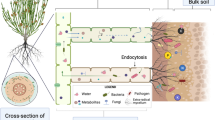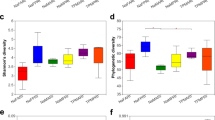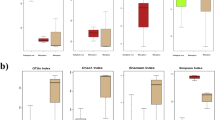Abstract
We employed an Illumina-based high-throughput metagenomics sequencing approach to unveil the rhizosphere and root endosphere microbial community associated with an organically grown Camellia population located at the Experimental Garden for Plantation Crops, Assam (India). The de novo assembled tea root endosphere metagenome contained 24,231 contigs (total 7,771,089 base pairs with an average length of 321 bps), while tea rhizosphere soil metagenome contained 261,965 sequences (total 230,537,174 base pairs, average length 846). The most prominent rhizobacteria belonged to the genera, viz., Bacillus (10.35%), Candidatus Solibacter (6.36%), Burkholderia (5.19%), Pseudomonas (3.9%), Streptomyces (3.52%), and Bradyrhizobium (2.77%), while the root endosphere was dominated by bacterial genera, viz., Serratia (46.64%), Methylobacterium (8.02%), Yersinia (5.97%), Burkholderia (2.05%), etc. The presence of few agronomically important bacterial genera, Bradyrhizobium, Rhizobium (each 0.93%), Sinorhizobium (0.34%), Azorhizobium, and Flavobacterium (0.17% each), was also detected in the root endosphere. KEGG pathway mapping indicated the presence of microbial metabolic pathway genes related to tyrosine metabolism, tryptophan metabolism, glyoxylate, and dicarboxylate metabolism which play important roles in endosphere activities, including survival, growth promotion, and host adaptation. The root endosphere microbiome also contained few important plant growth promoting traits related to phytohormone production, abiotic stress alleviation, mineral solubilization, and plant disease suppression.




Similar content being viewed by others
Availability of data and materials
The metagenomes are publically available in the NCBI-SRA database (PRJNA698063).
References
Aeron A, Kumar S, Pandey P, Maheshwari DK (2011) Emerging role of plant growth promoting rhizobacteria in agrobiology. In: Maheshwari DK (ed) Bacteria in agrobiology: crop ecosystems. Springer, Berlin, pp 1–36
Aquilanti L, Favilli F, Clementi F (2004) Comparison of different strategies for isolation and preliminary identification of Azotobacter from soil samples. Soil Biol Biochem 36:1475–1483. https://doi.org/10.1016/j.soilbio.2004.04.024
Barea J-M, Pozo MJ, Azcón R, Azcón-Aguilar C (2005) Microbial co-operation in the rhizosphere. J Exp Bot 56:1761–1778. https://doi.org/10.1093/jxb/eri197
Baruah P (2017) Wild teas of Assam and North East India. J Tea Sci Res. https://doi.org/10.5376/jtsr.2017.07.0007
Bhattacharyya PN, Sarmah SR (2018) The role of microbes in tea cultivation. In: Sharma VS, Gunasekare MTK (eds) Global tea science: current status and future needs, first. Burleigh Dodds science publishing, Cambridge, pp 135–168
Chen JL, Sun SZ, Miao CP et al (2016) Endophytic Trichoderma gamsii YIM PH30019: a promising biocontrol agent with hyperosmolar, mycoparasitism, and antagonistic activities of induced volatile organic compounds on root-rot pathogenic fungi of Panax notoginseng. J Ginseng Res 40:315–324. https://doi.org/10.1016/j.jgr.2015.09.006
Cole JR, Wang Q, Fish JA et al (2014) Ribosomal database project: data and tools for high throughput rRNA analysis. Nucleic Acids Res 42:D633. https://doi.org/10.1093/nar/gkt1244
Contreras-Cornejo HA, Macías-Rodríguez L, del-Val E, Larsen J (2018) The root endophytic fungus Trichoderma atroviride induces foliar herbivory resistance in maize plants. Appl Soil Ecol 124:45–53. https://doi.org/10.1016/j.apsoil.2017.10.004
de Godoy RCB, Deliza R, Gheno LB et al (2013) Consumer perceptions, attitudes and acceptance of new and traditional mate tea products. Food Res Int 53:801–807. https://doi.org/10.1016/j.foodres.2013.02.054
del Barrio-Duque A, Ley J, Samad A et al (2019) Beneficial endophytic bacteria-serendipita indica interaction for crop enhancement and resistance to phytopathogens. Front Microbiol. https://doi.org/10.3389/fmicb.2019.02888
Doanh N, Thuong N, Heo Y (2018) Impact of conversion to organic tea cultivation on household income in the mountainous areas of Northern Vietnam. Sustainability 10:4475. https://doi.org/10.3390/su10124475
Erbs G, Newman M-A (2003) The role of lipopolysaccharides in induction of plant defence responses. Mol Plant Pathol 4:421–425. https://doi.org/10.1046/j.1364-3703.2003.00179.x
Fernández-González AJ, Martínez-Hidalgo P, Cobo-Díaz JF et al (2017) The rhizosphere microbiome of burned holm-oak: potential role of the genus Arthrobacter in the recovery of burned soils. Sci Rep 7:6008. https://doi.org/10.1038/s41598-017-06112-3
Fernández-González AJ, Villadas PJ, Gómez-Lama Cabanás C et al (2019) Defining the root endosphere and rhizosphere microbiomes from the World Olive Germplasm Collection. Sci Rep 9:20423. https://doi.org/10.1038/s41598-019-56977-9
Gebrewold AZ (2018) Review on integrated nutrient management of tea (Camellia sinensis L.). Cogent Food Agric 4:1543536. https://doi.org/10.1080/23311932.2018.1543536
Goswami G, Deka P, Das P et al (2017a) Diversity and functional properties of acid-tolerant bacteria isolated from tea plantation soil of Assam. 3 Biotech 7:229. https://doi.org/10.1007/s13205-017-0864-9
Hajieghrari B, Mohammadi M (2016) Growth-promoting activity of indigenous trichoderma isolates on wheat seed germination, seedling growth and yield. Aust J Crop Sci 10:1339–1347. https://doi.org/10.21475/ajcs.2016.10.09.p7857
Harman GE, Doni F, Khadka RB, Uphoff N (2019) Endophytic strains of Trichoderma increase plants’ photosynthetic capability. J Appl Microbiol. https://doi.org/10.1111/jam.14368
Hassani MA, Durán P, Hacquard S (2018) Microbial interactions within the plant holobiont. Microbiome 6:58
Heeb S, Haas D (2001) Regulatory roles of the GacS/GacA two-component system in plant-associated and other Gram-negative bacteria. Mol Plant Microbe Interact 14:1351–1363
Hider RC, Kong X (2010) Chemistry and biology of siderophores. Nat Prod Rep 27:637. https://doi.org/10.1039/b906679a
Hu X, Chen J, Guo J (2006) Two Phosphate- and Potassium-solubilizing Bacteria Isolated from Tianmu Mountain, Zhejiang, China. World J Microbiol Biotechnol 22:983–990. https://doi.org/10.1007/s11274-006-9144-2
Huerta-Cepas J, Szklarczyk D, Forslund K et al (2016) EGGNOG 4.5: a hierarchical orthology framework with improved functional annotations for eukaryotic, prokaryotic and viral sequences. Nucleic Acids Res 44:D286–D293. https://doi.org/10.1093/nar/gkv1248
Hyatt D, Chen GL, LoCascio PF et al (2010) Prodigal: Prokaryotic gene recognition and translation initiation site identification. BMC Bioinform 11:119. https://doi.org/10.1186/1471-2105-11-119
Idris AL, Fan X, Muhammad MH et al (2020) Ecologically controlling insect and mite pests of tea plants with microbial pesticides: a review. Arch Microbiol 202:1275–1284. https://doi.org/10.1007/s00203-020-01862-7
Jayasinghe SL, Kumar L (2020) Climate change may imperil tea production in the four major tea producers according to climate prediction models. Agronomy 10:1536. https://doi.org/10.3390/agronomy10101536
Krauss U, Hidalgo E, Arroyo C, Piper SR (2004) Interaction between the Entomopathogens Beauveria bassiana, Metarhizium anisopliae and Paecilomyces fumosoroseus and the Mycoparasites Clonostachys spp., Trichoderma harzianum and Lecanicillium lecanii. Biocontrol Sci Technol 14:331–346. https://doi.org/10.1080/09583150410001665196
Lee Y-J, Yamamoto K, Hamamoto H et al (2005) A novel ABC transporter gene ABC2 involved in multidrug susceptibility but not pathogenicity in rice blast fungus, Magnaporthe grisea. Pestic Biochem Physiol 81:13–23. https://doi.org/10.1016/j.pestbp.2004.07.007
Lewis VG, Ween MP, McDevitt CA (2012) The role of ATP-binding cassette transporters in bacterial pathogenicity. Protoplasma 249:919–942. https://doi.org/10.1007/s00709-011-0360-8
Li H, Durbin R (2009) Fast and accurate short read alignment with Burrows–Wheeler transform. Bioinformatics 25:1754–1760. https://doi.org/10.1093/bioinformatics/btp324
Ma L, Cao YH, Cheng MH et al (2013) Phylogenetic diversity of bacterial endophytes of Panax notoginseng with antagonistic characteristics towards pathogens of root-rot disease complex. Antonie Van Leeuwenhoek 103:299–312. https://doi.org/10.1007/s10482-012-9810-3
Malekzadeh P (2015) Influence of exogenous application of glycinebetaine on antioxidative system and growth of salt-stressed soybean seedlings (Glycine max L.). Physiol Mol Biol Plants 21:225–232. https://doi.org/10.1007/s12298-015-0292-4
Meegahakumbura MK, Wambulwa MC, Li MM et al (2018) Domestication origin and breeding history of the tea plant (Camellia sinensis) in China and India based on nuclear microsatellites and cpDNA sequence data. Front Plant Sci. https://doi.org/10.3389/fpls.2017.02270
Meena KK, Sorty AM, Bitla UM et al (2017) Abiotic stress responses and microbe-mediated mitigation in plants: the omics strategies. Front Plant Sci. https://doi.org/10.3389/fpls.2017.00172
Mohanram S, Kumar P (2019) Rhizosphere microbiome: revisiting the synergy of plant–microbe interactions. Ann Microbiol 69:307–320
Mukhopadhyay M, Mondal TK, Chand PK (2016) Biotechnological advances in tea (Camellia sinensis [L.] O. Kuntze): a review. Plant Cell Rep 35:255–287. https://doi.org/10.1007/s00299-015-1884-8
Nath R, Sharma GD, Barooah M (2013) Screening of endophytic bacterial isolates of tea (Camellia sinensis L.) roots for their multiple plant growth promoting activities. Int J Agric Environ Biotechnol 6:371. https://doi.org/10.5958/j.2230-732X.6.3.005
Nath R, Sharma GD, Barooah M (2015) Plant growth promoting endophytic fungi isolated from tea (Camellia sinensis) shrubs of Assam, India. Appl Ecol Environ Res. https://doi.org/10.15666/aeer/1303_877891
Ramírez-Valdespino CA, Casas-Flores S, Olmedo-Monfil V (2019) Trichoderma as a model to study effector-like molecules. Front Microbiol 10:1030. https://doi.org/10.3389/fmicb.2019.01030
Sandhu SS, Sharma AK, Beniwal V et al (2012) Myco-biocontrol of insect pests: factors involved, mechanism, and regulation. J Pathog 2012:1–10. https://doi.org/10.1155/2012/126819
Scheepmaker JWA, Butt TM (2010) Natural and released inoculum levels of entomopathogenic fungal biocontrol agents in soil in relation to risk assessment and in accordance with EU regulations. Biocontrol Sci Technol. https://doi.org/10.1080/09583150903545035
Singh AK, Bisen JS, Chauhan RK et al (2016a) Tea research for Darjeeling tea industry: various aspects. In: Bag N, Bag A, Palni LMS (eds) Tea: technological initiatives, first. New India Publishing Agency, New Delhi, pp 195–239
Singh UB, Malviya D, Wasiullah D et al (2016b) Bio-protective microbial agents from rhizosphere eco-systems trigger plant defense responses provide protection against sheath blight disease in rice (Oryza sativa L.). Microbiol Res 192:300–312. https://doi.org/10.1016/j.micres.2016.08.007
Singh HB, Keswani C, Reddy MS et al (2019) Secondary metabolites of plant growth promoting rhizomicroorganisms: discovery and applications. Springer, Singapore
Smolińska U, Kowalska B (2018) Biological control of the soil-borne fungal pathogen Sclerotinia sclerotiorum—a review. J Plant Pathol 100:1–12
Sreenivasaprasad S, Manibhushanrao K (1990) Antagonistic potential of Gliocladium virens and Trichoderma longibrachiatum to phytopathogenic fungi. Mycopathologia 109:19–26. https://doi.org/10.1007/BF00437002
Tsurumaru H, Okubo T, Okazaki K et al (2015) Metagenomic analysis of the bacterial community associated with the taproot of sugar beet. Microbes Environ 30:63–69. https://doi.org/10.1264/jsme2.ME14109
van Tilburg AU, Thomas MD (1993) Production of extracellular proteins by the biocontrol fungus Gliocladium virens. Appl Environ Microbiol 59:236–242. https://doi.org/10.1128/AEM.59.1.236-242.1993
Vasiliou V, Vasiliou K, Nebert DW (2009) Human ATP-binding cassette (ABC) transporter family. Hum Genom 3:281–290. https://doi.org/10.1186/1479-7364-3-3-281
Verma M, Mishra J, Arora NK (2019) Plant growth-promoting rhizobacteria: diversity and applications. In: Sobti RC, Arora NK, Kothari R (eds) Environmental biotechnology: for sustainable future. Springer, Singapore, pp 129–173
Vieira S, Sikorski J, Dietz S et al (2020) Drivers of the composition of active rhizosphere bacterial communities in temperate grasslands. ISME J 14:463–475. https://doi.org/10.1038/s41396-019-0543-4
War Nongkhlaw F, Joshi S (2017) Microscopic study on colonization and antimicrobial property of endophytic bacteria associated with ethnomedicinal plants of Meghalaya. J Microsc Ultrastruct 5:132. https://doi.org/10.1016/j.jmau.2016.09.002
Wu S, Zhu Z, Fu L et al (2011) WebMGA: a customizable web server for fast metagenomic sequence analysis. BMC Genom 12:444. https://doi.org/10.1186/1471-2164-12-444
Xie C, Mao X, Huang J et al (2011) KOBAS 2.0: a web server for annotation and identification of enriched pathways and diseases. Nucleic Acids Res 39:W316. https://doi.org/10.1093/nar/gkr483
Xie H, Feng X, Wang M et al (2020) Implications of endophytic microbiota in Camellia sinensis: a review on current understanding and future insights. Bioengineered 11:1001–1015. https://doi.org/10.1080/21655979.2020.1816788
Yuan Y, Feng H, Wang L et al (2017) Potential of endophytic fungi isolated from cotton roots for biological control against verticillium wilt disease. PLoS One 12:e0170557. https://doi.org/10.1371/journal.pone.0170557
Yugandhar V, Chandrashekhar G, Bhattacharjee H (2018) Economics of growing tea organically in the initial years in terai zone of West Bengal condition. Int J Curr Microbiol Appl Sci 7:387–391. https://doi.org/10.20546/ijcmas.2018.705.050
Zhang S, Gan Y, Xu B (2016) Application of plant-growth-promoting fungi Trichoderma longibrachiatum T6 enhances tolerance of wheat to salt stress through improvement of antioxidative defense system and gene expression. Front Plant Sci 07:1405. https://doi.org/10.3389/fpls.2016.01405
Zhang Z, Zhou C, Xu Y et al (2017) Effects of intercropping tea with aromatic plants on population dynamics of arthropods in Chinese tea plantations. J Pest Sci (2004) 90:227–237. https://doi.org/10.1007/s10340-016-0783-2
Zhao H, Zhou T, Xie J et al (2020) Mycoparasitism illuminated by genome and transcriptome sequencing of Coniothyrium minitans, an important biocontrol fungus of the plant pathogen Sclerotinia sclerotiorum. Microb Genom. https://doi.org/10.1099/mgen.0.000345
Zhu YL, Pilon-Smits EAH, Jouanin L, Terry N (1999) Overexpression of glutathione synthetase in Indian mustard enhances cadmium accumulation and tolerance. Plant Physiol 119:73–79. https://doi.org/10.1104/pp.119.1.73
Zschiedrich CP, Keidel V, Szurmant H (2016) Molecular mechanisms of two-component signal transduction. J Mol Biol 428:3752–3775. https://doi.org/10.1016/j.jmb.2016.08.003
Acknowledgements
The authors are grateful to the Department of Biotechnology (DBT), Ministry of Science and Technology, Govt. of India for funding the research. The authors also kindly acknowledge the timely suggestions, encouragement, and reviews received from Professor B. K. Sarmah (Director, DBT-NECAB, AAU, Jorhat) throughout the research work.
Funding
This study was funded by the Department of Biotechnology, Govt. of India (DBT, GoI), through the DBT-North East Centre for Agricultural Biotechnology, Programme-III entitled “Gene prospecting from acid soil microbes.”
Author information
Authors and Affiliations
Contributions
MB had conceived and designed the study. SSB and MBorah had carried out the experiments and collected the data. SSB, KKD, MG, MKD, and MR had analyzed the data and prepared the charts. The manuscript was jointly written by SSB and MB.
Corresponding author
Ethics declarations
Conflict of interest
The authors declare that they have no conflict of interest.
Ethics approval
This study involved metagenomics of environmental samples only.
Consent to participate
NA.
Consent for publication
All the authors have given consent for publication.
Additional information
Communicated by Govarthanan Muthusamy.
Publisher's Note
Springer Nature remains neutral with regard to jurisdictional claims in published maps and institutional affiliations.
Supplementary Information
Below is the link to the electronic supplementary material.
Rights and permissions
About this article
Cite this article
Bora, S.S., Dey, K.K., Borah, M. et al. Niche differentiation of belowground microorganisms and their functional signatures in Assam type tea (Camellia sinensis var. assamica). Arch Microbiol 203, 5661–5674 (2021). https://doi.org/10.1007/s00203-021-02547-5
Received:
Revised:
Accepted:
Published:
Issue Date:
DOI: https://doi.org/10.1007/s00203-021-02547-5




